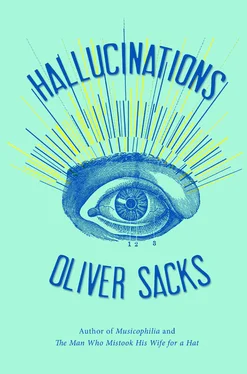David Ferrier, a contemporary of Gowers’s, moved to London in 1870, where he was mentored by Hughlings Jackson (Ferrier became a great experimental neurologist in his own right — he was the first to use electrical stimulation to map the monkey’s brain). One of Ferrier’s epileptic patients had a remarkable synesthetic aura, in which she would experience “a smell like that of green thunder.” (This is quoted by Macdonald Critchley in his 1939 paper on visual and auditory hallucinations.)
Hughlings Jackson described such seizures in 1875 and thought they might originate from a structure in the brain located beneath the olfactory cortex, the uncinate gyrus. In 1898 Jackson and W. S. Colman were able to confirm this by autopsy in Dr. Z., a patient who had died of an overdose of chloral hydrate. (More recently, David C. Taylor and Susan M. Marsh have recounted the fascinating history of Dr. Z., an eminent physician named Arthur Thomas Myers whose brother, F. W. H. Myers, had founded the Society for Psychical Research.)
In the 1946 film A Matter of Life and Death (called Stairway to Heaven in the United States), David Niven’s character, a pilot, has complex epileptic visions that are always preceded by an olfactory hallucination (the smell of burnt onions) and a musical one (a recurrent theme of six notes). Diane Friedman has written a fascinating book about this, indicating how meticulous the director, Michael Powell, was in consulting neurologists about the forms of epileptic hallucinations.
Penfield was a great physiologist as well as a neurosurgeon, and in the process of searching for epileptic foci, he was able to map most of the basic functions of the living human brain. He showed, for example, exactly where sensations and movements of specific body parts were represented in the cerebral cortex — his sensory and motor homunculi are iconic. Like Weir Mitchell, Penfield was an engaging writer, and after he and Herbert Jasper published their magnum opus, Epilepsy and the Functional Anatomy of the Human Brain , in 1958, he continued to write about the brain, as well as writing novels and biographies, until his death at eighty-six.
For Gowers and his contemporaries in the early twentieth century, memories were imprints in the brain (as for Socrates they were analogous to impressions made in soft wax) — imprints that could be activated by the act of recollection. It was not until the crucial studies of Frederic Bartlett at Cambridge in the 1920s and 1930s that this classical view could be disputed. Whereas Ebbinghaus and other early investigators had studied rote memory — how many digits could be remembered, for instance — Bartlett presented his subjects with pictures or stories and then questioned and requestioned them over a period of months. Their accounts of what they had seen or heard were somewhat different (and sometimes quite transformed) on each re-remembering. These experiments convinced Bartlett to think in terms not of a static thing called “memory,” but rather a dynamic process of “remembering.” He wrote:
Remembering is not the re-excitation of innumerable fixed, lifeless and fragmentary traces. It is an imaginative reconstruction, or construction, built out of the relation of our attitude towards a whole active mass of organized past reactions or experience.… It is thus hardly ever really exact.
Penfield sometimes used the term “flashback” for experiential hallucinations. The term is also used in quite different contexts, as in post-traumatic flashbacks, where there are recurrent hallucinatory replayings of traumatic events.
The term “flashback” is also used for a sudden, transient reexperiencing of a drug effect — suddenly feeling, for example, the effects of LSD, even though one has not taken it for months.
One such patient, who had very little in the way of religious interests as an adult, had his first religious seizure at a picnic, as Devinsky described to me: “His friends observed at first that he stared, became pale, and was unresponsive. Then suddenly, he began to run in circles for two or three minutes yelling, ‘I am free! I am free!… I am Jesus! I am Jesus!’ ”
The patient later had a similar seizure which was recorded on video EEG, and, just before the seizure, Devinsky noted, the patient was slow to respond and disoriented regarding time and place:
When asked if there was anything wrong, he replied: “nothing is wrong, I am doing well … I am very happy” and when asked whether he knew where he was, he replied with a smile and a surprised look: “Of course I know. I am in heaven right now;… I am fine.”
He remained in this state for ten minutes, then went on to a generalized seizure. Later, he remembered his ecstatic aura “as if it were a vivid and happy dream” from which he had now awoken, but he had no memory of the questions put to him during the aura.
She ran as a Republican in a district that had been Democratic for a very long time, and lost by only a narrow margin. Whenever she appeared in public during her campaign, she said that God had told her to run, and this apparently persuaded thousands of people to vote for her, despite her manifest lack of political experience or skills.
The evidence here has been discussed in a number of books, including Kevin Nelson’s The Spiritual Doorway in the Brain: A Neurologist’s Search for the God Experience . It is also the theme of a novel, Lying Awake , by Mark Salzman; the protagonist is a nun who has ecstatic seizures in which she communes with God. Her seizures, it turns out, are caused by a tumor in her temporal lobe, and it must be removed before it enlarges and kills her. But will its removal also remove her portal to heaven, preventing her from ever communing with God again?
Before seeing Ellen O., I had never heard of visual perseveration of such duration. Visual perseveration of a few minutes may be associated with cerebral tumors of the parietal or temporal lobes or may occur in temporal lobe epilepsy. There are a number of such accounts in the medical literature, including one by Michael Swash, who described two people with temporal lobe epilepsy. One of them had attacks in which “his vision seemed to become fixed, so that an image was retained for several minutes. During these episodes the real world was seen through the retained image, which was clear at first, but then gradually faded.”
Similar perseveration may occur with damage or surgery to an eye. My correspondent H.S. was blinded by a chemical explosion at the age of fifteen but had some sight restored by corneal surgery twenty years later. Following the operation, when his surgeon asked if he could now see the surgeon’s hand, H.S. replied, “Yes” — but then was astonished to see the hand, or its image, preserving its exact shape and position, for several minutes afterward.
In a letter to me, James Lance commented, “I have never encountered hallucination embracing information from the surroundings like Mr. H.’s.”
In addition to the overt delirium that may be associated with life-threatening medical problems, it is not uncommon for people to have slight delirium, so mild that it would not occur to them to consult a physician, and which they themselves may disregard or forget. Gowers, in 1907, wrote that migraine is “often attended by quiet delirium of which nothing can be subsequently recalled.”
Читать дальше












